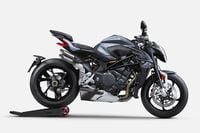The integrity of any threaded fastener is only as good as the guy who installs it. Meaning, of course, that if you over- or undertighten a bolt, you're headed for trouble. The question is, how do you know if the bolt in question is too tight, not tight enough or just right?
All threaded fasteners have a recommended torque setting you can find in your bike's shop manual or on a generic torque chart. But knowing the correct torque is only half the battle; you still need some way to measure it. That way is a torque wrench. Torque wrenches are available in three common styles. The most basic is the beam type. These use a simple pointer and scale to indicate the torque being applied. Next is the "clicker." Clickers use a micrometer-type scale built into the handle. The handle is rotated to a preset torque, say 10 foot-pounds. When the correct torque is reached, the wrench releases with an audible click. At the top of the food chain are dial-type torque wrenches. These incorporate a direct reading gauge that may be zeroed and a "tattle tale" to insure that the reading is dead-accurate every time. When selecting your torque wrench you'll need to decide which style you prefer, the appropriate drive size—1⁄4, 3⁄8 and 1⁄2 drives are the most common—the torque range and whether you want a wrench calibrated in inch-pounds, foot-pounds or Newton-meters of torque. The most versatile, and the one I'd recommend, would be a 3⁄8-drive, beam-type wrench with a range of zero–75 foot-pounds. Once you get in the habit of using it you'll wonder how you ever got along without it.
/cloudfront-us-east-1.images.arcpublishing.com/octane/GWCLFMIDN5FH6WWSGLCOSEZY7M.jpg)
/cloudfront-us-east-1.images.arcpublishing.com/octane/SNQEMPXRCBDKPCXJIN24D4J22M.jpg)
/cloudfront-us-east-1.images.arcpublishing.com/octane/GXHESE63GNGPLEOJ2JJANNGQ5Q.jpg)
/cloudfront-us-east-1.images.arcpublishing.com/octane/3USOOXJEHJB6NB2NNKU73HMRVY.jpg)
/cloudfront-us-east-1.images.arcpublishing.com/octane/6GLBGD7S75B7JP2GRYNEJO4TBE.jpg)
/cloudfront-us-east-1.images.arcpublishing.com/octane/SCA4CUE6YBHGRHKU7HEG3YHWGQ.jpg)
/cloudfront-us-east-1.images.arcpublishing.com/octane/LICXFHEM45CJZNVP6K36OVJSYQ.jpg)
/cloudfront-us-east-1.images.arcpublishing.com/octane/AJKZ2F5GIZEZREL5JQTKYYJ54E.jpg)
/cloudfront-us-east-1.images.arcpublishing.com/octane/R6QOQ7QOEJBVXP6CXT3R2LABII.jpg)
/cloudfront-us-east-1.images.arcpublishing.com/octane/KLI2FNJIQFEZVDXOAGYNOIN5HA.jpg)
/cloudfront-us-east-1.images.arcpublishing.com/octane/MVZFYJGVT5HRHC3XC3IT3IRPKE.jpg)
/cloudfront-us-east-1.images.arcpublishing.com/octane/JHRO6BMI45AZXB5TQ3RPZOQYPQ.jpg)
/cloudfront-us-east-1.images.arcpublishing.com/octane/BWG25O2D65H6LBEX4FQGHIBJAE.jpg)
/cloudfront-us-east-1.images.arcpublishing.com/octane/57PFATNDVBCCBFNWWTFYOFKSXM.jpg)
/cloudfront-us-east-1.images.arcpublishing.com/octane/TUXX7GKOQVFV7M7PAFUAPCJZXQ.jpg)
/cloudfront-us-east-1.images.arcpublishing.com/octane/DLOHA4WLMRFZRGJAKE7BYE2LPE.jpg)

/cloudfront-us-east-1.images.arcpublishing.com/octane/KILTQJNSDFDHTPC7DCUJ43S4CA.jpg)
/cloudfront-us-east-1.images.arcpublishing.com/octane/X47GL62AXNALRHQLLBELY5WRMY.jpg)
/cloudfront-us-east-1.images.arcpublishing.com/octane/7OY2GP3FWFEDVEMDSLNGM6PZRM.jpg)
/cloudfront-us-east-1.images.arcpublishing.com/octane/P3DLTISFGJA43L5QXVH7365UNY.jpg)
/cloudfront-us-east-1.images.arcpublishing.com/octane/SMCEQCLWRVEFTJJES6TAHB3OOQ.jpg)
/cloudfront-us-east-1.images.arcpublishing.com/octane/AIZFI3YH6FGRXNSFS3VJSUMSD4.jpg)
/cloudfront-us-east-1.images.arcpublishing.com/octane/6RJOKTWIJVHIZNNZH4T23I7SFA.jpg)
/cloudfront-us-east-1.images.arcpublishing.com/octane/IVGNJPSOSBHWTJRW4RLC2MXNME.jpg)